For various reasons I don’t keep a sleeping bag in my Get Home Bag or my everyday hiking kit. Today I thought I’d talk about other options than having a sleeping bag permanently stored in your kit.
First of all I think the best choice a person could make for a serious bug-out is a good sleeping bag, especially up here in the Great White North. Having said that, keeping a sleeping bag in your pack all the time has two disadvantages: 1.) They’re relatively heavy and 2.) If you keep your sleeping bag compressed all the time it will eventually lose its loft.
I keep my sleeping bags in a loose bag until I need them. With a good sleeping bag starting at $150 and up these days I want to protect my investment.
Purpose
The goal is to carry something in my pack that is light in weight, but warm enough to keep me alive if I have to use it to spend the night out. This means carrying different items during the various seasons up here in Maine.
I think it’s important to point out that these items are more for a regular day hiking kit or a get home bag (GHB) than a full five day hiking pack or a long term Bug-Out Bag. Unless you’re very skilled and hard-core you’ll probably want to carry something heavier (like a sleeping bag) if you’re going for an over nighter or a multiple day hike.
The idea here is to have something with you on a regular hike that’s light enough to keep you warm if you get caught out overnight, but not heavy enough to kill you hiking it up a mountain because of its weight.
For example: if I wanted to hike a mountain here in Maine this time of year (it’s May 11, 2014 as I write this) and the temperature today was around 72 degrees. Tonight it could easily go down into the 30’s. That means if I go out on a day hike carrying what the typical day hiker carries, (water bottle, power bar, and maybe an extra t-shirt ) the last thing I’m thinking about is that it’s going to get cold that night. I’ll sweat on the hike getting my clothes wet, which means if I get lost and have to spend a night out with wet clothes, no shelter and no way to start a fire, I’m a prime candidate for hypothermia.
Bear in mind this is about survival and not comfort. That’s not saying that if you use these as effectively as possible they won’t keep you warm.
Knowledge
A quick word here about knowledge and skills. If all you have is a poncho liner and poncho and the temperature is going into the 30’s you are going to get cold; however, if you start a fire and reflect the heat back into a shelter you’ve found or made you’ll be much warmer and might even be able to catnap through the night.
This type of knowledge is a force multiplier, which means if you take your piece of gear by itself it will help a little. But if you combine it with your knowledge of starting a fire you will not only survive the night you’ll be comfortable as well. They become more effective when used together.
This is true of any gear you put in your pack. Try to make sure it has multiple uses or is important enough to have a spot.
Wool Blanket
There are many good things to be said about wool. When it gets wet it still retains a good deal of its ability to keep you warm unlike cotton, which will kill you if it gets wet in cold weather.There are many kinds of wool blankets out there on the market. I bought a military surplus blanket off Amazon and so far it’s held up pretty good.
You can keep it rolled up tight and it won’t lose its ability to keep you warm, which is what happens to a sleeping bag after it’s lost its loft. This means you can put it in your pack and forget about it until you need it.
The wonderful thing about a wool blanket is the rage of uses you can get out of it. There are many YouTube videos out showing many ways to use the blanket as a cloak. All you need is a way to pin it and it’ll become a great cloak or overcoat to wear while you’re in the woods.
It can be used in different ways such as a cloak, or as a shelter, or just roll up in it and sleep in it next to a fire. If a spark lands on the blanket it won’t cause the same damage as it would on a synthetic sleeping bag.
Don’t forget that in cold weather a big part of the battle for staying warm is to put some insulation between you and the ground. If you don’t have a sleeping pad gather some leaves or fir boughs and try to put six inches of this insulating material between you and the ground. This will help keep you warm.
The wool blanket is quite a bit heavier than the poncho liner, but it’s also a lot warmer on its own.
Poncho Liner and Poncho
To be fair I almost always use the poncho liner in conjunction with the poncho unless I’m in the southern latitudes. When I was in Gitmo, Cuba sleeping on a cot I used a poncho liner, but it was easily in the 70’s at night with a light sea breeze, so it was no big deal. In North Carolina and other southern states it worked well in the summer because it’s so hot down there. In the fall I would either pair it up with the poncho or use a light sleeping bag.
Up here in Maine I’ve attached it to the military poncho, which is a heavier duty poncho than the Wal-Mart variety, and then folded the poncho in half and buttoned it up to create a sleeping bag. This works pretty well, but I haven’t really tested it much below 55 or 60 degrees. That means I’d want to use this configuration in the summer. One thing I like about the poncho/poncho liner combination is that it gives you a variety of uses. You could use the poncho by itself to keep the rain off, or set it up as a shelter, or use it to funnel rain water, and many other uses.
The poncho liner by itself is a very lightweight blanket. You could use it to help camouflage a position, or you can wrap up in it as a blanket and it will do a fair job of keeping you warm. Combine the two and you can make a decent sleeping bag.
Weight
The military grade poncho and poncho liner together when compared with the wool blanket weigh roughly the same. If it’s going to be cold and wet I’ll carry the poncho and the blanket. It’s the heaviest combination, but also the warmest and it still won’t drive my pack weight up past 20 lbs. and that’s including my other gear.
Other Options
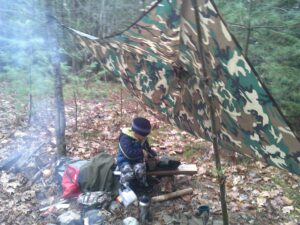
Branching out a little another option I use in the summer is a heavy duty space blanket and a ripstop poncho. This is not a military grade poncho and it’s a little smaller, but I’ve slept under it (in a sleeping bag) and it seemed to be up to the task of becoming a shelter without coming apart. Whereas the military poncho is square, this one has more of a rectangular shape, which I didn’t realize until I went to set it up. No biggie, but I did have to adjust the design of my shelter accordingly that trip. The ripstop poncho is also much lighter than it’s military cousin.
I haven’t really tested the space blanket under harsh conditions. The thing to remember about this is that it reflects heat and is not insulative. It’s silver on one side and olive drab on the other. Very light though, and compresses down fairly well. It reminds me of a small tarp to some extent. It is not like the cheap silver space blankets you see everywhere.
Conclusion
These are all good pieces of gear to have on hand if you want to carry something relatively light.
The lightest combination is the rip stop poncho with the space blanket. A very good solution for summer time.
The next heaviest is the military poncho with the poncho liner. This combination probably has the most uses with the individual pieces capable of many different functions.
The heaviest is the wool blanket with a poncho for shelter or keeping the rain off.
The main advantages of carrying these pieces of gear are:
- They are lighter than a sleeping bag.
- You can put them in your pack and forget about them until you need them. This way you don’t have to worry about losing the loft in your sleeping bag.
- In warmer weather they are perfectly acceptable for sleeping. People get so hung up on sleeping in a sleeping bag they forget there are other options out there.
I have at least six sleeping bags, but the equipment listed above is what I use in my personal GHB and hiking pack.
Any of you woodsmen out there have an alternative?
Questions? Comments?
Sound off below!

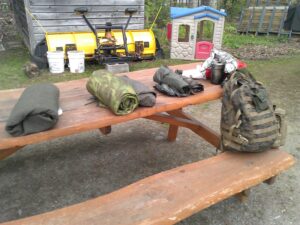
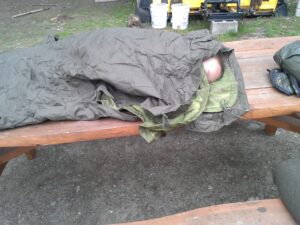
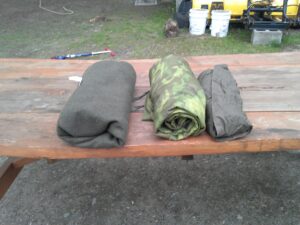
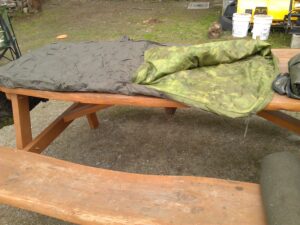
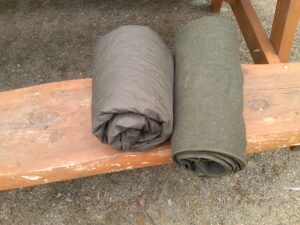
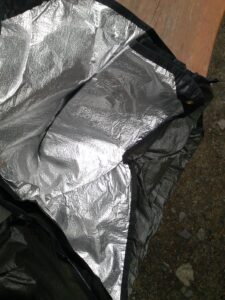
29 comments
another traditional alternative to the sleeping bag was TWO wool blankets…
each folded in half length-wise, forming a double thick “tube” and then under, at the feet. (“blanket pins” optional) the deluxe version featured a “straw tick” underneath for more insulation and padding.
the “space blanket” never seemed as warm to me as wool.
one I had, (bought used) completely disintegrated.
(probably from extended sunlight exposure)
I took the other one with me “surf fishing” and was cold most of the night. YMMV. it gave me a good excuse to make a driftwood fire.
IRISHDUTCHUNCLE Try one space blanket, then poncho liner, add one more space blanket and one more poncho liner.. Demonstration done by Reallybigmonkey1
When selecting a “wool blanket” read the label (or description) carefully. Some of the more recognizable surplus outlets are now marketing “wool emergency blankets” with as much as 70% poly and only 30% wool. This might be okay if you are under cover from rain or snow, but I prefer the 70% wool variety. There are also some Swiss blankets around that are 90%, but of course more money.
Another thing to research is making a “Match Coat” from your wool blanket. Dave Canterbury has (or had) a couple of interesting how-to videos on this topic on his Pathfinder School website. A Matchcoat can be worn to dry the blanket and will keep you warm both night (as a blanket) or during the day (as a coat).
I’ve never had good results from a “space blanket” and I can tell you that listening to the damn thing all night when someone else is using one will deny you some sleep. The crinkling sound is enough to drive you crazy. Boy, but are they noisy!
SD
I remember using one of those heavy-duty space blankets, described by Jarhead, when I was in SERE school. At that time of the year the night time temperatures probably didn’t get below the mid-30s. It did a decent job and I actually got some sleep, but they do make more noise than I’m comfortable with. That being said, they’re relatively small and lightweight, so I’d pack one for emergencies but not ultra-light camping.
I love wool blankets, if you can find one that is actually made of mostly wool (SEBAGO DAD’s post above is spot on). However, for my kit I choose the military poncho and poncho liner. Both are excellent pieces of gear. You may not sleep soundly if it’s freezing cold outside, but you’re more likely to survive than if you had nothing, and you’ll stay drier and lighter.
Great post! These types of comparison/contrast posts are helpful!
keep in mind that a ghb is used to get home, quickly. i used all of the above in the army. had good nights in cooler weather tying two liners together with the poncho, even better with the “sportsman’s” space blanket. in a get-home situation, i’m hiking 20 plus hours and catching a catnap rolled up in my liner up against a tree or in a stand of pines. when i get cold, i’ll get moving. it isn’t a camping trip. that said, some guys are using the goretex bivy cover with a liner or blanket inside, no tarp at all.
You can’t go wrong with any of those pieces. They all serve a purpose or two. Let me throw some weights at you all to help in the decision process.
These weights are on my digital scale.
All items can be at + or – 10%
That means that 2 identical looking pieces can weigh different.
So these are a good generalization.
Poncho Ripstop Military Style 10 oz
Poncho Current Issue Woodland 1 lb 8 oz
Poncho Old OD Vietnam + era 2 lb 12 oz
Poncho German Issue Cold War era 2 lb 1 oz
Poncho Liner Current Woodland 20 – 21 oz
Poncho Liner Current Marpat 22 oz
Poncho Liner 80’s OD 28 oz
Wool Blanket US Issue 80’s 3 lb 10 oz
Wool Blanket Swiss 80’s 2 lb 8 oz
US Issue Goretex Bivy 2 lb 1 oz
Just thought I would throw that in.
I got soo crazy with weights that I weighed all my web gear looking for a piece that was lighter than the rest. I have duffels full, it took me all day this winter and about a pint of whiskey. These weights are averages of what I have.
There are some great lightweight sleeping bags out there that pack down to the size of a football too.
Awesome information, Pineslayer. I have to get me one of those digital scales.
“Travel light, freeze at night!” Used to be our watchword.
ours too. only then they kept adding crap until it was “pack like a mule,still freeze at night.”
Great advice, Sebago Dad. The one I use is 70% wool and it keeps me nice and warm.
I’ve never tried that configuration. Is it heavy?
well, yeh. I wasn’t thinking.
it’s about the heaviest, as it turns out.
(Pineslayer did the weighing, see below), unfortunately it comes out heavier than many sleeping bags. plus it’s bulky. the idea came from my old Boy Scout Handbook. the blankets get rolled into a horseshoe shape, and carried across the top, draped down the sides, of the “Yucca” pack.
(I suppose I’d carry it over one shoulder, tied on the opposite side, across my back and chest) my current plan is to make a TYVEK tarp, to use with the blanket or poncho liner, then keep the poncho handy for use in the rain.
…and I’d definitely lose the straw tick, or the pine boughs in favor of a G.I. foam pad.
As far as loss of loft in a sleeping bag, I have not found this to be an issue. I have a 30-year old Slumberjack bag that spent all but a few weekends a year stuffed into a sack and it seems just as fluffy today as it was when I bought it.
I’ve read that down bags won’t lose loft as fast as synthetic. Is this a down bag you’re talking about, Chuck?
Nope, it’s made from a filling called Holofill (sp?) some number after that maybe 808. I know there are 2 (or was) kinds of Holofil and my bag was the lesser expensive one.
I like the fact that this particular space blanket can double as a tarp if need be.
Did you do your SERE training here in Maine?
Since I was coming from Okinawa, my SERE training was in Southern California. The classroom portion was held at the Coronado Naval Air Station in San Diego and the field portions, including the resistance training lab, were conducted in Warner Springs.
I would have loved to have attended SERE at both the SoCal and Maine locations just to train in different environments and climates. SERE was always my favorite military training, and I wish it could be made into a “pipeline” school for all new military members.
I’ve had my bag for over 25 yrs. Except for airing out, it’s always stuffed in the bag, and usually tied to my pack. No problems with loft/fluff
Man, I’m torn on this one.
Sleeping bags aren’t really needed down here unless its really cold. Even a wool blanket is pretty much only necessary 2 months out of the year and that only for a few days at a time. Hardly ever snows (once in a 100 years or so) so the other 10 months – probably will not be needed.
A poncho liner is more like it. Much lighter weight and paired with the poncho, probably good to the low 50’s if sat down and tucked underneath. And they can be paired with one of my favorite ‘sleep out’ arrangements, the hammock. The poncho liner can be wrapped around the bottom to hammock to keep bugs from reaching underneath and biting and simultaneously cover you on top. The poncho in that case is used as a tarp cover from overnight dew.
We might be lacking in the sleeping bags department but have the space blankets in the GHB. Our commute to and from work is about 14 miles and even in the worst conditions, I always have apparrel for the season in the bag as a back up. I like the poncho and poncho liner idea. We had looked at this option too before going with the space blankets. For planned trips out of the normal commute, we have the 5 gallon bucket option that goes in the trunk to include more food and some longjohns.
I have to say the two wool blankets halved and made in a tube are my goto in terms of a camp. I used that setup in 14 degree weather next to a fire and I was good till my toes got cold. I think I could go another 15 degrees down if I added a fleece bag to my set up.
As Jason mentions, fleece needs to be looked at. It melts easy, but it does a good job insulating when wet. It is cheap and light, good for the budget conscientious. It ain’t wool. I found some Swiss? fleece bags for $5 at SG a couple of years ago, they were big, beasty, and Deep Purple in color. Good buy.
I have a wool blanket that I got in a heavy bag from a garage sale that a local volunteer fireman sold. It has snaps on the bag to go on a wall. I have it hanging in my van on a wall. it’s waiting for my van to die on me on a cold night. I really haven’t used it much and it looks like new. I don’t think the local fireman used it much (no blood stains on it…) either.
I suppose I should buy another wool blanket that is a bit lighter as it’s a heavy thing. Way too heavy to backpack. But then I don’t backpack any more. You can never have too many preps and supplies, unless you are moving, then it kinda sucks…
what I also want to know: will the space/casualty blanket reduce my IR signature enough to allow me to evade the Predator? FLIR?
I don’t like the idea that I’ve become the “enemy” in my own country. Yeh, this is not a “camping trip”, or a walk in the park.
… and if my ability to start a fire comes in to play, then I should have brought the sleeping bag along. I’m probably going to freeze.
(not having much luck lighting the charcoal lately)
I like the linen ponchos and wool blankets, however I found a waterproof wool picnic blanket is very good. Handmade and waterproof blanket.
I actually carry both.the poncho liner and poncho plus a wool blanket. It allowsme tolsyer up and the wool blankt buttoned up inside the liner a poncho make for a toasty nite sleep
I actually carry both.the poncho liner and poncho plus a wool blanket. It allows me to layer up and the wool blanket buttoned up inside the liner a poncho make for a toasty nite sleep.
What kind of poncho did you use for that combo ? I’m thinking about using that set up for my car. Is it a GI Poncho ?
Thanks